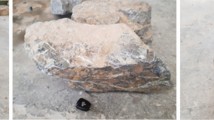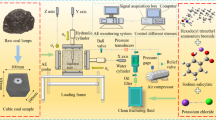Abstract
Geofluids widely exist in natural rocks, and the fluid overpressure affects the mechanical behavior of rocks, triggering dynamic instability events. To investigate the role of pore fluid in low-permeability coal away from excavation boundary but still influenced by the periodic excavation disturbance, a series of undrained cyclic triaxial compressive tests were conducted on saturated coal. The results show that pore water has little effect on the axial strain evolution of coal, but has a significant effect on the radial and volumetric strain evolution. Different from dry coal, the saturated coal samples (except the coal samples SUC 1-1 and SUC 1-2 which show a slight volume shrinkage stage) show dilation deformation directly without any volume shrinkage, due to regional overpressure caused by the undrained condition. With this constraint against crack closure, a low frictional strength of crack surfaces was produced, favoring instability. Moreover, the saturated coal cracks cannot close tightly at the loading stage due to water propping effect, resulting in that the crack could not keep stationary, instead it slips throughout the loading and unloading processes. Also, the pore overpressure provides tensile stress, producing a large number of macro-tensile cracks in the final failure. This tensile cracking process is influenced by the loading frequency, as the pore pressure decay lags behind the unloaded stress, producing pore overpressure to tensile cracking in the unloading process. This lag effect becomes more prominent with the increase of cyclic loading frequency. Consequently, the number of tensile cracks of saturated coal at the loading frequency of 0.4 Hz is larger than that at the loading frequency of 0.1 Hz.
Highlights
-
The pore overpressure promote the deformation growth to the direction of minimum principal stress.
-
Dilatancy occurred directly from the start of loading for saturated coal due to regional overpressure.
-
Pore overpressure provides tensile stress to the crack, producing a large number of macro tensile cracks in the final failure of the coal.
-
The number of tensile cracks of saturated coal increased with the cyclic loading frequency due to the prominent lag effect of strain behind stress.


















Similar content being viewed by others
Data Availability
Not applicable.
Code Availability
Not applicable.
References
Alvarez GM, Miedema SA, van de Ketterij RG, Yenigül NB, van Rhee C (2015) Effect of high hyperbaric pressure on rock cutting process. Eng Geol 196:24–36
Bai H, Ma D, Chen Z (2013) Mechanical behavior of groundwater seepage in karst collapse pillars. Eng Geol 164:101–106
Bidgoli MN, Jing L (2015) Water pressure effects on strength and deformability of fractured rocks under low confining pressures. Rock Mech Rock Eng 48:971–985
Cai X, Zhou Z, Liu K, Du X, Zang H (2019) Water-weakening effects on the mechanical behavior of different rock types: phenomena and mechanisms. Appl Sci 9:4450
Castelletto N, Ferronato M, Gambolati G, Janna C, Marzorati D, Teatini P (2013) Can natural fluid pore pressure be safely exceeded in storing gas underground? Eng Geol 153(2):35–44
Cho N, Martin CD, Sego DC (2007) A clumped particle model for rock. Int J Rock Mech Min Sci 44(7):997–1010
Elst N, Savage HM, Keranen KM, Abers GA (2013) Enhanced remote earthquake triggering at fluid-injection sites in the midwestern United States. Science 341:164–167
Faulkner DR, Sanchez-Roa C, Boulton C, Hartog SD (2018) Pore fluid pressure development in compacting fault gouge in theory, experiments, and nature. Int J Rock Mech Min Sci 44(7):997–1010
Ferrero AM, Migliazza M, Tebaldi G (2010) Development of a new experimental apparatus for the study of the mechanical behaviour of a rock discontinuity under monotonic and cyclic loads. Rock Mech Rock Eng 43:685–695
French ME, Zhu W (2017) Slow fault propagation in serpentinite under conditions of high pore fluid pressure. Earth Planet Sci Lett 473:131–140
Gao Q, Ghassemi A (2017) Pore pressure and stress distributions around a hydraulic fracture in heterogeneous rock. Rock Mech Rock Eng 473:131–140
Gatelier N, Pellet F, Loret B (2002) Mechanical damage of an anisotropic rock under cyclic triaxial tests. Int J Rock Mech Min Sci 39:335–354
Hardebeck JL, Hauksson E (1999) Role of fluids in faulting inferred from stress field signatures. Science 285:236–239
Helmons R, Miedema SA, Grima MA, Rhee CV (2016) Modeling fluid pressure effects when cutting saturated rock. Eng Geol 211:50–60
Hillis R (2000) Pore pressure/stress coupling and its implications for seismicity. Explor Geophys 31:448–454
Huang Z, Jiang Z, Zhu S, Wu X, Yang L, Guan Y (2016) Influence of structure and water pressure on the hydraulic conductivity of the rock mass around underground excavations. Eng Geol 202:74–84
Kang B, Jian L, Wei Z, Zheng X, Ni S, Liu Z (2018) Mechanical behavior and damage constitutive model of rock subjected to water-weakening effect and uniaxial loading. Rock Mech Rock Eng 52:97–106
Kim K, Franklin JA, Bowling AJ, Lecomte P, Grob H (1999) International society for rock mechanics commission on testing methods. Int J Rock Mech Min Sci Geomech Abstr 24:53–73
Leclère H, Faulkner D, Wheeler J, Mariani E (2016) Permeability control on transient slip weakening during gypsum dehydration: implications for earthquakes in subduction zones. Earth Planet Sci Lett 442:1–12
Leclère H, Faulkner D, Llana-Fúnez S, Bedford J, Wheeler J (2018) Reaction fronts, permeability and fluid pressure development during dehydration reactions. Earth Planet Sci Lett 496:227–237
Lei X, Tamagawa T, Tezuka K, Takahashi M (2011) Role of drainage conditions in deformation and fracture of porous rocks under triaxial compression in the laboratory. Geophys Res Lett 38:24310
Li H, Ogawa Y, Shimada S (2003) Mechanism of methane flow through sheared coals and its role on methane recovery. Fuel 82:1271–1279
Liu H, Zhu W, Yu Y, Xu T, Liu X (2020) Effect of water imbibition on uniaxial compression strength of sandstone. Int J Rock Mech Min Sci. https://doi.org/10.1016/j.ijrmms.2019.104200
Mckavanagh B, Stacey F (1974) Mechanical hysteresis in rocks at low strain amplitudes and seismic frequencies. Phys Earth Planet Inter 8:246–250
Miao F, Wu Y, Li L, Tang H, Li Y (2018) Centrifuge model test on the retrogressive landslide subjected to reservoir water level fluctuation. Eng Geol 245:169–179
Minardi A, Ferrari A, Ewy R, Laloui L (2018) Nonlinear elastic response of partially saturated gas shales in uniaxial compression. Rock Mech Rock Eng 51(7):1967–1978
Reviron N, Reuschlé T, Bernard JD (2009) The brittle deformation regime of water-saturated siliceous sandstones. Geophys J Int 178(3):1766–1778
Roshan H, Rahman SS (2011) Analysis of pore pressure and stress distribution around a wellbore drilled in chemically active elastoplastic formations. Rock Mech Rock Eng 44:541–552
Sakurovs R, He L, Melnichenko YB, Radlinski AP, Blach T, Lemmel H, Mildner D (2012) Pore size distribution and accessible pore size distribution in bituminous coals. Int J Coal Geol 100:51–64
Song Z, Konietzky H, Fruehwirt T (2019) Hysteresis and dynamic response features of concrete exposed to repeated multilevel compressive loading. J Mater Civ Eng. https://doi.org/10.1061/(ASCE)MT.1943-5533.0002703
Tan QB, Zhang R, Gao MZ, Liu QY, Zhang ZT, Jia ZQ (2017) Coal permeability and crack distribution characteristics in unloading confining pressure experiments under different water pressures. Therm Sci 21(1):241–249
Tang SB (2018) The effects of water on the strength of black sandstone in a brittle regime. Eng Geol 239:167–178
Tang SB, Yu CY, Heap MJ, Chen PZ, Ren YG (2018) The influence of water saturation on the short- and long-term mechanical behavior of red sandstone. Rock Mech Rock Eng 51(9):2669–2687
Vásárhelyi B (2005) Statistical analysis of the influence of water content on the strength of the miocene limestone. Rock Mech Rock Eng 38:69–76
Vishal V, Ranjith PG, Singh TN (2015) An experimental investigation on behaviour of coal under fluid saturation, using acoustic emission. J Nat Gas Sci Eng 22:428–436
Wasantha P, Ranjith PG (2014) Water-weakening behavior of Hawkesbury sandstone in brittle regime. Eng Geol 178:91–101
Yao Q, Chen T, Tang C, Sedighi M, Huang Q (2019) Influence of moisture on crack propagation in coal and its failure modes. Eng Geol. https://doi.org/10.1016/j.enggeo.2019.105156
Ye ZW, Zhang L, Hao DY, Zhang C, Wang C (2017) Experimental study on the response characteristics of coal permeability to pore pressure under loading and unloading conditions. J Geophys Eng 14(5):1020–1031
Yerkes RF, Castle RO (1976) Seismicity and faulting attributable to fluid extraction. Eng Geol 10:151–167
Yu B, Zhang Z, Kuang T, Liu J (2016) Stress changes and deformation monitoring of longwall coal pillars located in weak ground. Rock Mech Rock Eng 49(8):3293–3305
Zhong C, Zhang Z, Ranjith PG, Lu Y, Choi X (2019) The role of pore water plays in coal under uniaxial cyclic loading. Eng Geol. https://doi.org/10.1016/j.enggeo.2019.05.002
Acknowledgements
This study was financially supported by the National Natural Science Foundation of China (Grant Nos. 51674047 and 51911530152) and the National Science Fund for Distinguished Young Scholars (Grant No. 51625401).
Author information
Authors and Affiliations
Contributions
CZ: conceptualization, methodology, formal analysis, and writing—original draft; ZZ: conceptualization, methodology, and writing—review and editing; PGR: writing—review and editing; CZ: writing—review and editing; KX: methodology and writing.
Corresponding author
Ethics declarations
Conflict of interest
The authors declare that they have no conflict of interest.
Additional information
Publisher's Note
Springer Nature remains neutral with regard to jurisdictional claims in published maps and institutional affiliations.
Rights and permissions
About this article
Cite this article
Zhong, C., Zhang, Z., Ranjith, P.G. et al. The Role of Pore Pressure on the Mechanical Behavior of Coal Under Undrained Cyclic Triaxial Loading. Rock Mech Rock Eng 55, 1375–1392 (2022). https://doi.org/10.1007/s00603-021-02705-7
Received:
Accepted:
Published:
Issue Date:
DOI: https://doi.org/10.1007/s00603-021-02705-7




